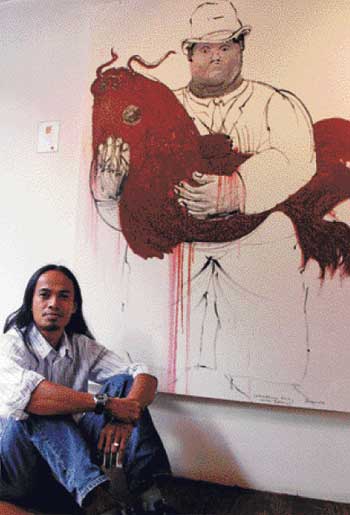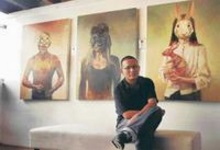New Straits Times, 8 June 2007
SEE: Filtering the filtered
by Debra Chong
Aided by six articulate artists, DEBRA CHONG attempts to get to the bottom of art, truth, life, the universe and a cup of cold coffee.
THE visual artist has more freedom than the writer, postulates Anurendra Jegadeva, quickly adding that he speaks purely from a fine arts perspective.
Better known in art circles as J. Anu, he was one of six artists who were on hand at the Wei-Ling Gallery in Brickfields to talk about their participation in its current exhibition, Filtered.
The six were part of a larger group of 11 contemporary Malaysian artists chosen for their acute awareness of the world around them and their bold response to current issues and its impact upon society.
Take for example, Anu’s study on the migrant Indian community in Malaysia, based on his perception of Hindu astrology and its divine influence over a person’s fate and faith.
“The Indian community here is very accepting of their conditions. There’s nothing wrong with that. I think it is very brave and noble of them,” said the Johor-born artist.
However, he also believes that the whole idea of Fate and Faith “can become a crutch”.
Ninth Planet is a careful composition of a man and woman framed by nine globular icons of Indian myth and stories representing the nine planets (here given a local flavour). At first glance, it would appear that they form the centre of the universe.
However, as Anu argued, it also seems as if they were trapped, boxed in by the very gods they revere.
If his arguments seem ambivalent, it is deliberately so. His filters do not cater to only one party; rather, he chooses to mix two opposing flavours to create a more rounded taste, sort of like your cup of cham (a Hainanese drink blending coffee and tea).
“Things don’t simply change overnight. I want people to think about the issues but it doesn’t have to be ugly or confrontational. I am trying to present a difficult subject matter in the most beautiful terms,” he charged.
Meanwhile, Roslisham Ismail, better known as Ise, has no qualms with presenting a horrifically ugly subject starkly. On a trip to Indonesia last year, he saw a wanted poster of Malaysians Azahari Husin (deceased) and Noordin Mt Top (at large), who are believed to have masterminded the Bali bombings. His Export is a crude repackaging of that poster, blown up and reprinted on canvas and specially framed in gilt.
After Anu’s beautiful “packaging”, it made me grimace when I first saw the painting; it was distasteful and seemed to smack of sheer sensationalism. I even considered filtering it out altogether. But as the cheery artist explained: “We always speak of packaging as being very important. I wanted to show that not all of our exports are good.”
His close friendship with many Indonesians led to a mutual empathy of their anger and their grief. As a Malaysian, he felt deeply shamed that his countrymen had been part of such gross acts on a neighbour, which led to a burning desire to show the rest of his countrymen the realities that had been filtered out.
“Not many Malaysian are aware unless they go to Indonesia a lot. I have a responsibility to show something, the reality of the situation, the emotions of the Indonesian people, what were their reactions when confronted by such things: why, why do these people kill? Why do they do such things? Apa mereka perjuangkan?
If Anu’s social realism is defined by the heavens, and Ise’s by a hell, then Ivan Lam’s is defined by consumerism.
“I’m always for consumerism. We’re defined by what we consume,” said the artist, disguised as a lecturer at a local institution based in Cyberjaya.
Tol/ VSOP is a three-part parody of the recent debacle over the classified documents between highway concessionaires and the Government, which resulted in a toll hike throughout the Klang Valley.
Part 1 features an image of the toll plaza at Kota Kemuning, and made more pointed by the text statement (Part 2): “Criminals like artists are opportunity seekers.” Over the top, a partially visible numerical print, 2 20, makes a commercial allusion to the hiked price. It is also a clue to the proverbial udang di sebalik batu.
A walk around the back of his painting reveals yet another sardonic statement, based on a Hennessey ad from long ago: “Live life to the fullest.”
Taken all together, Lam’s images produce a bitter cynical concentrate, harsh on the tongue and on the brain.
“Art is like magic. A work of art is deceptive. If everyone is a magician, then no one is a magician,” he said.
His cryptic words, when decoded, point out that many people allow themselves to be misled by illusions rather than choose to learn the truth.
“If everyone does it (choose to exercise their brain), then change can happen.”
Hamir Soib shares a similar sentiment. Having been in the scene for 14 years, he cannot bear to see artists repeating themselves and recycling the same motifs.
“Artists should play a big role in making change happen. Instead of waiting, we have to do something to make things happen,” he proclaimed.
His contribution to the exhibition is called Something Fishy, a blatant dig at the MAS “controversy” involving Fernando Botero’s paintings. It features a rotund man, fashioned in the Colombian artist’s style, holding a large fish in his arms.
As an artist, Hamir had followed the case closely and felt angered and insulted by the million-ringgit purchase of the Botero painting. “Is it because there is a lack of good artists in Malaysia” and again when the Botero collection was flown by MAS to be displayed not in Malaysia for the benefit of local artists and arts aficionados, but in Singapore.
“MAS is a Malaysian carrier; why do I have to go all the way down to Singapore just to see it?”
For Zulkifli Yusof, art does not have to be a stand-alone experience. Currently, he is producing a series based on his reading of Frank Swettenham’s Malay Sketches. While he has contributed three pieces to the exhibition, Reformasi, Amuk Di Pasir Salak 2, it is his last that he wanted to talk about.
Lucky Day was inspired by Chapter 14, A Malay Romance. The chapter chronicles the relationship between husband and wife, Raja Iskandar and Raja Maimunah, which is plagued by social problems of that time: smoking, gambling, womanizing and adultery.
“Raja Maimunah herself, though she affects a demure façade, is actually very sexy. She’s able to convey a wealth of sexiness through her eyes alone. It reminds me of the lyrics (from How Me Seksi, by Too Phat featuring Inul Daratista) “ku seksi, seksi seksi sekali / Dari hujung rambut hingga hujung kaki”.
“After reading it, I see no difference in the social problems between then and now. That’s where I got the idea for Lucky Day. The kuda calendar depicting the gambling nature and showing the days are all the same, that history repeats itself; actually, the problems are the same now as previously,” he says enthusiastically, eyes gleaming.
“I am inspired from reading, books, magazines, manuscripts. When you read, your mind travels; it makes you question things. I like to read about the past, about what we should learn and compare with the present day. I like that statement of Swettenham’s: How important it is to live with the society in order to understand that society,” said Zukifli, a methodological artist.
Says Marvin Chan: “Painting is to have a discourse. To provoke thought. I love paintings, the ideas to be discussed. It means we’re now communicating.”
Sadly, he sees very little of that happening now, as fewer artists produce art that is relevant to the era they live in and therefore cease to engage the viewers.
“The truth is fragmented. Check out Wall Street, it used to be a slaughterhouse. They turned it into a stock market. How appropriate,” he quipped.
His three paintings for Filtered are set in the same sardonic tone; there is The Evil Good-doer, The Immaculate Politician and The Perpetual Child, what Chan sees as archetypes perpetrated throughout society. Indeed, he considers himself to be a little bit of all three, with the clownish mask of The Immaculate Politician being foremost.
“Being an artist is not a professional choice. It is a lifestyle choice,” says the former award-winning advertising art director. For him, it was with a certain degree of awareness that followed his marriage and birth of his children.
“I was in advertising; winning awards. I got married, had children. I had an epiphany then. What do I tell the kids? What will be proof of my existence? I didn’t want to be a hypocrite,” he said quietly, leaning back into his chair and draining his cup of coffee while mine grew cold on the table.
Filtered is thought-provoking on many layers. Essentially, it deals with artists intellectually wading through filtered information and sifting the grains of truth from the chaff generated by the mass media machinery, and then producing their own versions of Truth, based on their personal experiences in order to provoke a response from the viewer in hopes of inducing change.
At the end of the session, I felt as if I’d overdosed on caffeine. There was Anu frappucino, Ise drip coffee, Hamir with a white top, Marvin black, but Zulkifli should have been taken on the rocks, because his “flavour”, as Chan quipped, was “too intense”.
Due to the lack of space, the writer has had to filter the artists’ responses to Filtered. Ironic, isn’t it?
For a deeper appreciation of their artistic intellect, the reader is strongly encouraged to visit Wei-Ling Gallery. The exhibition is ongoing until Friday. June 15, 2007.


